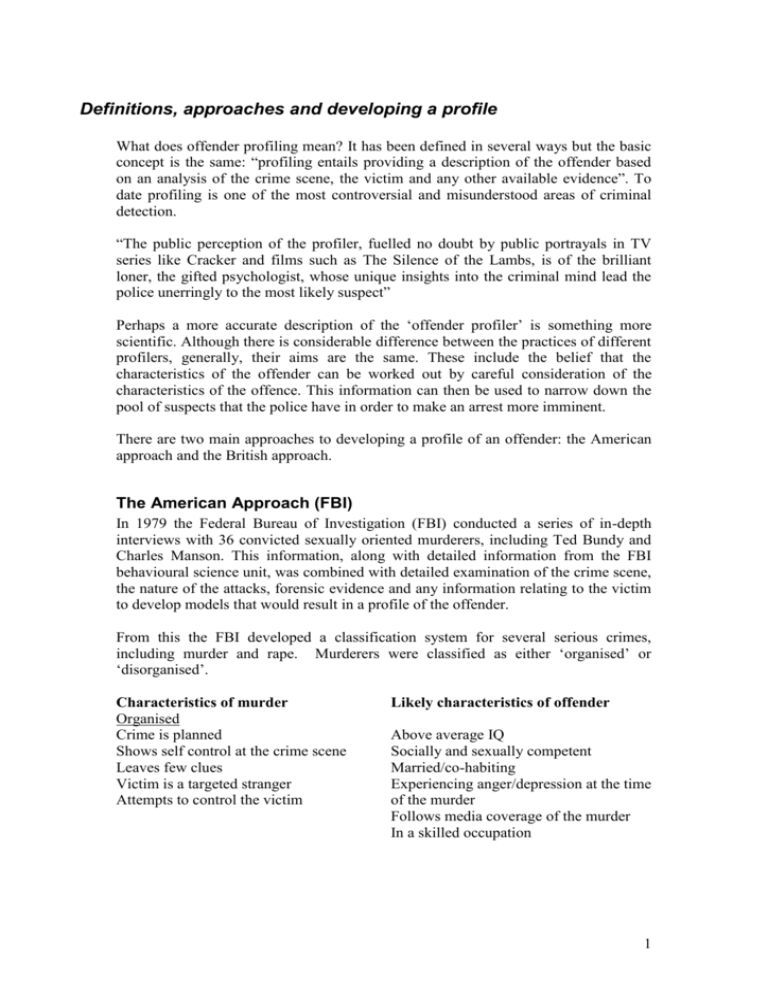
Definitions, approaches and developing a profile
What does offender profiling mean? It has been defined in several ways but the basic
concept is the same: “profiling entails providing a description of the offender based
on an analysis of the crime scene, the victim and any other available evidence”. To
date profiling is one of the most controversial and misunderstood areas of criminal
detection.
“The public perception of the profiler, fuelled no doubt by public portrayals in TV
series like Cracker and films such as The Silence of the Lambs, is of the brilliant
loner, the gifted psychologist, whose unique insights into the criminal mind lead the
police unerringly to the most likely suspect”
Perhaps a more accurate description of the ‘offender profiler’ is something more
scientific. Although there is considerable difference between the practices of different
profilers, generally, their aims are the same. These include the belief that the
characteristics of the offender can be worked out by careful consideration of the
characteristics of the offence. This information can then be used to narrow down the
pool of suspects that the police have in order to make an arrest more imminent.
There are two main approaches to developing a profile of an offender: the American
approach and the British approach.
The American Approach (FBI)
In 1979 the Federal Bureau of Investigation (FBI) conducted a series of in-depth
interviews with 36 convicted sexually oriented murderers, including Ted Bundy and
Charles Manson. This information, along with detailed information from the FBI
behavioural science unit, was combined with detailed examination of the crime scene,
the nature of the attacks, forensic evidence and any information relating to the victim
to develop models that would result in a profile of the offender.
From this the FBI developed a classification system for several serious crimes,
including murder and rape. Murderers were classified as either ‘organised’ or
‘disorganised’.
Characteristics of murder
Organised
Crime is planned
Shows self control at the crime scene
Leaves few clues
Victim is a targeted stranger
Attempts to control the victim
Likely characteristics of offender
Above average IQ
Socially and sexually competent
Married/co-habiting
Experiencing anger/depression at the time
of the murder
Follows media coverage of the murder
In a skilled occupation
1
Disorganised
Little planning/preparation
Lives alone, near to crime scene
Little attempt to hide evidence at the Sexually and socially inadequate
crime scene
In an unskilled occupation
Minimum use of constraint
Physically/sexually abused in childhood
Random, disorganised behaviour
Frightened and confused at the time of
the attack
Evaluation
Strengths
Useful: enormously influential and has
had success in other countries.
Applications: has been used to solve
many high profile cases. Good for
crimes such as rape, arson, cult killings,
that reveal important details about the
suspect.
Qualitative data: interviews with
offenders provided loads of qualitative
data.
Weaknesses
Subjective: Not based on firmly
established psychological theories –
subjective judgements of the profiler as to
what category a person falls into.
Reductionist: typologies are reductionist.
Sample & Reliability: Based on
interviews with small number of
convicted offenders known to be
manipulative and attention seeking –
unreliable
The British Method (investigative psychology)
Offender profiling in Britain began some years after the Americans had practiced it.
This approach is more scientific than the American approach in that it uses more
psychological theories and methodologies. Professor David Canter has spearheaded
this approach. It attempts to look for ways in which the crime might mirror the
behaviour of the offender in everyday life (the criminal consistency hypothesis).
Canter (1989) outlines several aspects of criminal behaviour that may provide clues to
other aspects of the criminal’s everyday life. The consistency principle has been
applied to two areas: interactions between the victim and the offender (interpersonal
consistency) and the geographical area in which the criminal commits the crime
(spatial consistency).
Interpersonal Consistency
Canter describes how perpetrators interactions with their victim may provide clues
about how that person interacts with people in everyday life. For example the degree
of violence used in serious crimes, especially rape, may reflect how the criminal treats
other women in his non-criminal life.
2
A rape where the offender does not initiate a high level of sexual contact indicates
someone with a low level of sexual activity in other areas of life. This profile
would suggest a man living alone.
The use of impersonal or degrading language would suggest a man who considers
women to be objects of desire in other areas of life. This profile would include
failed domestic relationships or difficult relationships with women a work.
An offender who warns a victim not to go to the police or destroys evidence
would suggest that the offender had knowledge of police procedure from previous
offences. This profile would include a criminal record.
The type of victim may also reflect the sub-group to which the criminal belongs.
Canter uses the example of Ted Bundy who killed over 30 students when he himself
was a student. On a psychologically deeper level, the choice of victims may reflect a
group, against which the perpetrator has a particular grudge.
Spatial Consistency
One way of understanding the geographical patterns of offender is to consider spatial
consistency, the idea that serial offenders operate in a limited area. Spatial
consistency is based on the idea of mental maps. Mental maps are people’s internal
representations of the external world and are unique to each individual. A taxi driver,
for example, will have a different mental map of an area than a non-taxi driver.
Criminals draw on their mental maps when committing a crime so that an area in
which an offence takes place has boundaries. These are unconscious and are a
consequence of the offender’s experience of their environment. They are likely to take
into account such factors as escape routes, presence of CCTV and access to victims.
Your mental map of College probably took into account of bus routes, roads,
pathways, or things that you have experienced in the environment. For example if you
regularly travel to College on a bus, your mental map is likely to include the bus stop
you use.
Gregory and Canter (1994) identified two spatial patterns of offenders: marauders and
commuters. Marauders use a fixed base (often home) whereas the commuter travels to
the crime location. If the pattern of offences suggests a detailed knowledge of the
area, then it is likely the offender is a marauder and not a commuter. Therefore, the
profile would include an estimation of the location of the offender’s home base.
Evaluation
Strengths
Applications: no reason why Canter’s
approach should be limited to just
profiling certain types of crimes (murder
and rape).
Quantitative data: Use of statistical
methods means quantitative data will be
produced – a more objective approach
Weaknesses
Idiosyncratic: lack of united approach
across profilers could result in variations
in success rates.
3
Biases and pitfalls in profiling
Does profiling work? The extent to which profiling works is difficult to estimate since
the successes are given considerable media attention whilst the failures are not.
Some researchers believe that it is ineffective, unnecessary and unhelpful. Campbell
(1976) suggests that profiles offer no more information than could be obtained from
the local bartender! One way of assessing the effectiveness of profiling is to conduct
satisfaction surveys.
Copson 1995 – What do you think of it?
A study was conducted by Copson (1995), which reviewed the usefulness of offender
profiling in Britain. Copson conducted a survey using a questionnaire, which was sent
to police officers who had used profilers.
50% of respondents felt that the profilers had provided something extra to the
investigation
80% reported that the advice had been useful.
14% of respondents reported that it had assisted in solving the case.
3% of cases it led to the identification of the offender.
How then had it been useful? The main way was that it furthered the understanding
of the case/offender. The benefits of offender profiling were seen mainly not so much
in identifying the offender but having an intelligent second opinion that may provide
new ways of approaching the case. It seems that profiling does assist in solving
crimes but its effect is indirect rather than direct.
Evaluation
Strengths
Applications: shows us where profilers
are of use and what it is that they
actually contribute to investigations.
Quantitative data: Use of statistical
methods means quantitative data will be
produced – a more objective approach
Weaknesses
Social Desirability: questionnaire used
and officers could lie on them. Even if a
profiler had helped massively would they
say that or take the credit themselves?
Data: only quantitative data collected –
subjective interpretation of the questions
and their meaning. No depth.
Pinizzoto & Finkel 1990 – Are profilers really any better?
Here the researchers compared 5 groups on their ability to write profiles of a
homicide and a sex offence. Each of the participants in the five groups were given a
scenario of a real crime, then asked using their knowledge of psychology, policing or
past experience to write up a profile of the offender. These profiles were analysed
afterwards to compare them to the actual characteristics of the offender who was
charged with the offence. The five groups of participants were:
4
Expert profilers
Detectives with profiling experience
Detectives with no profiling experience
Clinical psychologists
Undergraduates
Profilers were significantly more accurate than non-profilers on the sex offence but
not as accurate as the detectives on the homicide case. This suggests that experience
may be far more important in profiling a case than training in psychological profiling.
Evaluation
Strengths
Applications: shows us that profilers are
of and that they provide specialist
knowledge to police.
Sample: a good range of people were
selected allowing us to see if profilers
have any specialist knowledge or skills
that non-profilers don’t have.
Weaknesses
Coding: The profiles collected would
require interpretation by the researchers.
5
Applied profiling – John Duffy
The following case study is based on the account by Canter (1994) of the profiling of
the so-called ‘Railway Rapist’. Canter learnt about the case from a newspaper that
contained details of a series of 24 sexual assaults in London over the past 4 years. All
the assaults were assumed to be by the same man, sometimes working alone,
sometimes with a partner. Canter began to look for obvious patterns to the rapes.
Although the police had gathered a wealth of evidence, with every detail of every rape
carefully recorded, there was no direction to the investigation and Canter described
the overall impression of the investigation as one of ‘great confusion’. Following
Canters involvement they began to look in greater detail at the assailant’s behaviour
during each rape:
What exactly was said to the victim before the assault?
Were the victims’ clothes pulled off, torn off, or cut off?
What sorts of threats were made?
What sort of sexual activity took place?
How did the assailant deal with the victim?
All these details were fed into a computer in order to indicate the degree of similarity
and difference between the crimes.
Firstly Canter looked at the behaviour shown at the scene of each rape. Canter used
his interpersonal consistency theory to predict how the rapist interacted with women
in everyday life. In this case, the rapist talked to his victims, asked them questions
about their personal life. He also had only used enough control to rape and was
therefore probably not a very powerful or secure individual. There was an indication
that he knew about police procedure (in one instance he combed the victims pubic
hair to remove evidence of his own).
Canter also applied his spatial consistency theory to this case and produced a map of
where each offence had taken place in relation to the other offences. From this Canter
produced the following preliminary profile:
6
Residence: Has lived in area circumscribed by the first three rapes
Marital Status: probably lives with wife/girlfriend, quite possibly without
children
Age/description: mid to late 20’; light hair; about 5’ 9”.
Occupation: probably semi-skilled job, involving weekend work or casual
labour from June 1984 onwards.
Character: keeps to himself but has one or two very close men friends.
Probably very little contact with women, especially in work situation. Has
knowledge of the railway system along which attacks happened.
Sexual activity: the variety and mixture of his sexual actions suggest
considerable sexual experience and would have fantasises about rape and
bondage.
What factors led to this profile? Lets consider one aspect – he was in a sexual
relationship, married or cohabiting. What led to this conclusion when more of the men
who are convicted of rape are unmarried than are married? The rapist was sexually
experienced and was at ease approaching women (he would ask for directions etc)
This evidence could be used to hypothesise that he was, or had been, in a sexual
relationship, probably abusive. This example shows how every aspect of the profile is
a result of painstaking analysis of the minute details of the crimes, not the result of
‘flashes of inspiration’!
In November 1986 John Duffy was arrested and later convicted; he was sentenced to
life imprisonment. He was originally on a list of 2,000 suspects but not a prominent
one, placed as 1,505th on the list. His arrest followed a large-scale surveillance
operation, the result of the fact that he so closely fitted the profile.
How close was the profile? Duffy lived in Kilburn which matched the area in the
profile; he was 29 years old and had been a rapist for 4 years; he had been married but
had separated after the relationship became abusive; he was a travelling carpenter for
British rail; he had a prior criminal record; he only had 2 male friends (one of which
was his co-offender); he kept hard-core porn videos and liked tying his wife up before
sex; he kept souvenirs from the crimes – 33 door keys, each taken from a victim. The
analysis had been extraordinarily accurate.
Evaluation
Strengths
Applications: shows us that profiles do
work and can be very useful to help the
police direct their resources effectively.
Ecological Validity: this was a real case
so there is lots of e.v.
Weaknesses
Sample: a good range of people were
selected allowing us to see if profilers
have any specialist knowledge or skills
that non-profilers don’t have.
7
Past Essay Questions
Section A
a. Outline one approach to offender profiling. [6]
b. Discuss the usefulness of offender profiling. [10]
Section B
a. Describe what psychologists have found out about offender profiling [10]
b. Evaluate what psychologists have found out about offender profiling [16]
c. You have been asked to develop a profile to help identify someone who has
stolen a baby from a hospital. Suggest the steps you will go through to develop
this profile. Give reasons for your answer [8]
8
Model Answer – Section B
a) Throughout the study of offender profiling two main approaches have materialised,
the British approach and the American approach.
The American, or ‘top-down’, approach was compiled by the FBI through a series of
in-depth interviews with 36 convicted sexually orientated murderers, including Ted
Bundy and Charles Manson. This information, along with detailed information from
the FBI Behavioural science unit, was combined with detailed examination of the
crime scene, the nature of attacks, forensic evidence, and any information relating to
the victim to develop models that would result in a profile of the offender. From this
the FBI developed a classification system for several serious crimes. Murders were
classified as either ‘organised’ or ‘disorganised’ and a set of characteristics was built
from this. Organised offenders would show planning in their crimes, leave few clues,
and target a stranger; from this it was possible to infer that they would be above
average IQ, be socially and sexually competent and in a skilled occupation. Those
categorised as disorganised would show the opposite traits.
The British, or ‘bottom-up’, approach is more scientific than the American approach
in that it uses more psychological theories and methodologies. This approach looks
for ways in which the crime might mirror the behaviour of the offender in every day
life – the Criminal Consistency Hypothesis (Canter (1989)). This consistency
principle has been applied to two areas: interactions between the victim and the
offender (interpersonal consistency); and the geographical area in which the criminal
commits the offence (spatial consistency). Within interpersonal consistency it is
argued, for example, that the degree of violence used in serious crimes, especially
rape, may reflect how the criminal treats other women in his non-criminal life.
Spatial consistency is based on the idea of mental maps; criminals then draw on these
mental maps when committing a crime. Two types of offenders were highlighted: the
marauders who use a fixed base (usually home) and offend around that central point;
or commuters who travel far to the location of the crime to disassociate themselves
from the geographic location.
Finally, a further issue that psychologists have found while investigating offender
profiling is that there are biases and pitfalls in profiling. The extent to which profiling
works is difficult to estimate since the successes are given considerable media
attention (for example John Duffy) whilst the failures are not. Some researchers
believe that it is ineffective, unnecessary and unhelpful. Copson (1995) sent a
questionnaire to police officers who had used profilers in the past to review the
usefulness of profiling in Britain. It was found that 50% of respondents felt that the
profilers had provided ‘something extra’ and 80% felt that they had been useful;
however, only on 3% of cases did the profile directly lead to a conviction. Therefore,
there are mixed views on the effectiveness of profilers, but in many cases they have
provided invaluable to help direct police resources in the right area, or give a better
understanding of the characteristics of the offender so to eliminate certain people
from enquiries (Canter (1994)).
9
b) An initial problem with research into offender profiling lies in the researchers only
focusing on one variable that could be the cause an offender committing a crime; this
is known as being reductionist. For example, the American approach uses topologies
to categorise offenders as either organised or disorganised. Some offenders could
show characteristics of both topologies. In contrast, the British approach uses a
variety of psychological theories to provide an understanding of how an offenders’
behaviour during an offence relates to their everyday life therefore allowing for many
more variables to be taken into account and thus not being reductionist. Research that
is reductionist is problematic as it doesn’t look at the entire range of influences on
behaviour and we may get a distorted picture of the behaviour being investigated.
A further criticism of studies in this area is we could have problems generalising the
results to offenders of different crimes, locations, races, or genders. For example, the
John Duffy case study showed how the British approach can be used to aid the police
to apprehend an offender; however, as it this is only one offender, the results cannot
be generalised reliably to all offenders of different crimes, genders, ages etc.
Similarly, the American approach is based on only 36 offenders, and all of the crimes
were sexually orientated murders; therefore, again the resulting theories cannot be
generalised to other offences. Even though these samples don’t represent all
offenders, we maybe able to extrapolate the data to other groups which would provide
useful applications.
Following on, the research presented in this area has many useful applications to the
real world. We are able to use the results to predict why some criminals offend, and
also design strategies to intercept and catch offenders. For example, the American
approach allows psychologists to classify offenders as one of the two topologies, and
as a result provides certain personal characteristics about the offender that could allow
police to target their enquiries more efficiently. Similarly, the British approach has
proved its usefulness through applications such as the John Duffy case (Canter
(1994)). This case provided strong support for using the criminal consistency
hypothesis to create a profile of the offender and the profound effects a profile could
have on apprehending an offender.
Quantitative data, or data in numerical form, is easy to collect and analyse, and
therefore provide statistical evidence as to the effectiveness of offender profiling. For
example, Copson (1995) used a questionnaire to collect data on the effectiveness of
profiling in Britain from a sample of police officers who had the use of a profiler
during investigations. This data was able to show that profilers are effective in
indirectly helping police. In contrast, Pinizzoto & Finkel (1990) used a more
qualitative approach to discover if profilers, students, or police officers were more
able to write a reliable profile of an offender from case notes. The profiles collected
would require interpretation by the researchers to discover the reliability of the
profile, but allowing a more in-depth look at the reliability of profiles in general.
10








